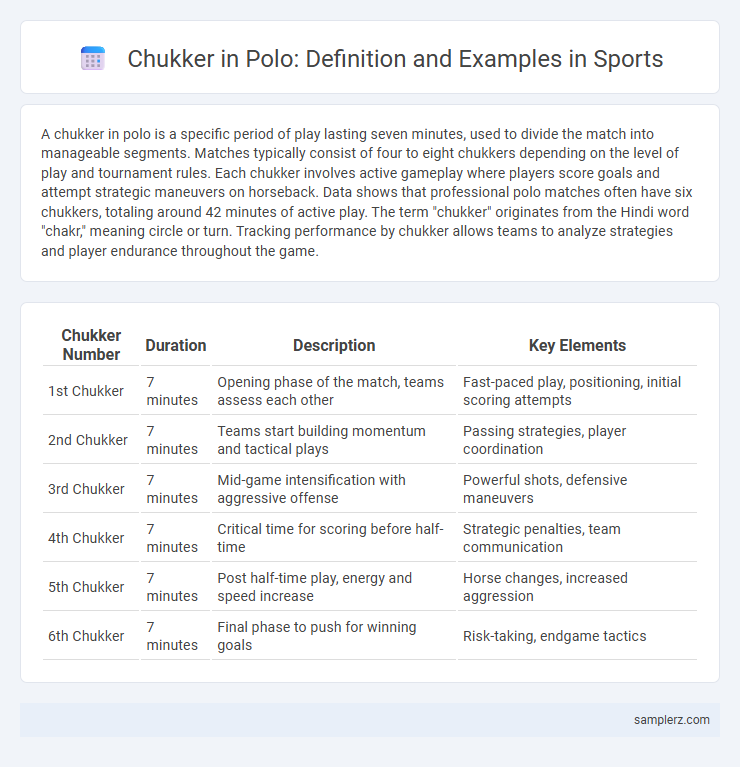A chukker in polo is a specific period of play lasting seven minutes, used to divide the match into manageable segments. Matches typically consist of four to eight chukkers depending on the level of play and tournament rules. Each chukker involves active gameplay where players score goals and attempt strategic maneuvers on horseback. Data shows that professional polo matches often have six chukkers, totaling around 42 minutes of active play. The term "chukker" originates from the Hindi word "chakr," meaning circle or turn. Tracking performance by chukker allows teams to analyze strategies and player endurance throughout the game.
Table of Comparison
| Chukker Number | Duration | Description | Key Elements |
|---|---|---|---|
| 1st Chukker | 7 minutes | Opening phase of the match, teams assess each other | Fast-paced play, positioning, initial scoring attempts |
| 2nd Chukker | 7 minutes | Teams start building momentum and tactical plays | Passing strategies, player coordination |
| 3rd Chukker | 7 minutes | Mid-game intensification with aggressive offense | Powerful shots, defensive maneuvers |
| 4th Chukker | 7 minutes | Critical time for scoring before half-time | Strategic penalties, team communication |
| 5th Chukker | 7 minutes | Post half-time play, energy and speed increase | Horse changes, increased aggression |
| 6th Chukker | 7 minutes | Final phase to push for winning goals | Risk-taking, endgame tactics |
Understanding the Structure of a Chukker in Polo
A chukker in polo typically lasts 7 minutes, consisting of continuous, fast-paced play that emphasizes team strategy and horsemanship. Each chukker allows players to showcase their skills in offense and defense while managing horse stamina by rotating mounts between periods. Understanding the structure of a chukker is crucial for appreciating how pacing, player positioning, and equipment maintenance impact the overall flow and outcome of the game.
Duration and Timing Rules for Each Chukker
A chukker in polo typically lasts seven minutes of active play, with the clock stopped during breaks or injuries to ensure precise timing. Standard matches consist of four to eight chukkers, with a 3-minute interval between each period for player rest and horse changes. Strict enforcement of these duration and timing rules maintains the sport's fast-paced, strategic nature.
Player Rotation and Substitution During Chukkers
In polo, a chukker typically lasts 7 minutes and includes strategic player rotation to maintain peak performance and prevent fatigue. Substitutions often occur between chukkers or during stoppages, allowing fresh players or horses to enter the match without disrupting game flow. Effective management of player rotation and substitutions during chukkers enhances team stamina and tactical advantage.
Key Moments Within a Polo Chukker
A chukker in polo consists of seven and a half minutes of intense, fast-paced play divided into key moments where players execute tactical offense and defense. Critical moments include the opening charge, where possession is contested aggressively, and the mid-chukker phase, characterized by strategic positioning and passing to penetrate the opponent's defense. The final minute intensifies as teams push for scoring opportunities, often resulting in crucial goals or turnovers that can shift game momentum.
Scoring Opportunities in Every Chukker
Each chukker in polo lasts seven and a half minutes, providing multiple scoring opportunities as teams aggressively maneuver the ball downfield. Players capitalize on fast breaks, tactical passes, and coordinated team plays to create openings for goals in every chukker. Effective use of the mallet, horse speed, and positioning during chukkers directly influences the game's momentum and scoring outcomes.
Tactics Teams Use Across Chukkers
Chukkers in polo last seven minutes each and teams strategically adjust player positions to exploit opponents' weaknesses, aiming to control the field and maintain possession. Tactical plays often involve rapid sprints and precise passing between mounts to advance the ball efficiently through each chukker. Maintaining stamina and coordinating offensive and defensive maneuvers across chukkers enables teams to outmaneuver rivals and secure scoring opportunities.
Fitness and Horse Management Between Chukkers
Maintaining optimal fitness and horse management between chukkers is crucial in polo to ensure peak performance and safety. Players engage in tailored warm-up exercises while horses undergo targeted cooling-down routines, including trotting and walking, to prevent muscle fatigue and overheating. Strategic hydration, balanced nutrition, and real-time health monitoring of horses between chukkers enhance recovery and sustain energy levels throughout the match.
Notable Chukker Performances in Polo History
A chukker in polo, lasting 7 minutes, showcases intense skill and strategy crucial to match outcomes, with notable performances like Adolfo Cambiaso's dominant seventh chukker in the 2012 Argentine Open demonstrating exceptional horsemanship and precision. The 1995 U.S. Open featured a pivotal fifth chukker played by Memo Gracida that shifted momentum, highlighting the importance of tactical awareness during these periods. Historic chukkers often define legendary careers, emphasizing endurance, teamwork, and split-second decision-making central to polo's competitive legacy.
Chukker Strategies for Beginners
A chukker in polo lasts seven minutes and involves intense periods of play where strategy is crucial for beginners to master positioning, ball control, and teamwork. New players should focus on maintaining strong communication with teammates to anticipate opponents' moves and efficiently manage horse stamina. Emphasizing defensive maneuvers during transitions helps beginners gain tactical awareness and improve their overall game performance.
Impact of Chukker Rules on Match Outcomes
Chukker rules in polo, consisting of timed periods typically lasting seven and a half minutes, significantly influence match outcomes by dictating the pace and energy management of players and horses. Strict adherence to chukker regulations ensures fair play and strategic substitutions, often determining momentum shifts and ultimate victory in high-stakes tournaments like the Argentine Open. Violations such as exceeded chukker durations or illegal player rotations can lead to penalties, directly affecting team standings and competitive dynamics.

example of chukker in polo Infographic
 samplerz.com
samplerz.com